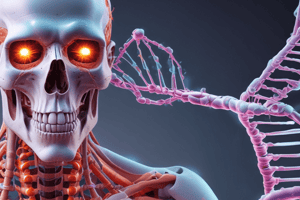Podcast
Questions and Answers
What is the main outcome when an atom is ionized?
What is the main outcome when an atom is ionized?
- The atom becomes more stable.
- The atom's chemical properties change. (correct)
- The atom's charge decreases.
- The atom's mass increases.
What is the primary mechanism by which X-rays cause damage to human tissue?
What is the primary mechanism by which X-rays cause damage to human tissue?
- Ionization and excitation of orbital electrons. (correct)
- Direct interaction with DNA.
- Stimulation of immune response.
- Interruption of blood flow.
Which of the following is NOT a potential outcome of exposure to high levels of radiation?
Which of the following is NOT a potential outcome of exposure to high levels of radiation?
- Skin burns
- Cataracts
- Leukemia
- Heart attack (correct)
What is the primary purpose of the ALARA principle in medical imaging?
What is the primary purpose of the ALARA principle in medical imaging?
What does the term 'stochastic effects' refer to in the context of radiation exposure?
What does the term 'stochastic effects' refer to in the context of radiation exposure?
What is the study of the effects of ionizing radiation on biologic tissue called?
What is the study of the effects of ionizing radiation on biologic tissue called?
Which of the following is a deterministic effect of radiation on humans?
Which of the following is a deterministic effect of radiation on humans?
Which of the following populations has been observed to have an increased incidence of thyroid cancer due to radiation exposure?
Which of the following populations has been observed to have an increased incidence of thyroid cancer due to radiation exposure?
What % of the human body is made up of oxygen and hydrogen?
What % of the human body is made up of oxygen and hydrogen?
What is the primary goal of radiobiologic research?
What is the primary goal of radiobiologic research?
Flashcards
Deterministic Effects of Radiation
Deterministic Effects of Radiation
Effects that increase in severity with higher radiation doses, occurring within days.
Stochastic Effects of Radiation
Stochastic Effects of Radiation
Effects that occur randomly with higher radiation doses, not seen immediately.
Acute Radiation Syndrome
Acute Radiation Syndrome
A serious health condition resulting from high radiation exposure, with subtypes like hematologic and gastrointestinal syndromes.
Leukemia from Radiation
Leukemia from Radiation
Signup and view all the flashcards
Radiobiology
Radiobiology
Signup and view all the flashcards
ALARA
ALARA
Signup and view all the flashcards
Ionization
Ionization
Signup and view all the flashcards
Deterministic Effects
Deterministic Effects
Signup and view all the flashcards
Stochastic Effects
Stochastic Effects
Signup and view all the flashcards
Recovery from Sublethal Damage
Recovery from Sublethal Damage
Signup and view all the flashcards
Study Notes
Human Radiation Response
- X-rays are harmful. If sufficiently intense, x-rays can cause skin burns, cataracts, cancer, leukemia, and other harmful effects.
- X-rays are derived from the job of radiologic technologists, radiologists, and medical physicists to produce high-quality x-rays images with minimal radiation exposure.
- This approach to patients and radiation workers is reasonably known as ALARA.
- This chapter examines the concepts of human biology and discusses the known radiosensitivity of tissues, organs, and cells.
- The effect of x-rays on humans is the result of interactions of the x-rays on atoms. These interactions take the form of ionization or excitation of orbital electrons and result in the deposition of energy in tissue.
- Deposited energy can produce a molecular change, the consequences of which can be measurable if the resultant human injury.
- When an atom is ionized, its chemical binding properties change. If the atom is a constituent of a large molecule, relaxation may result in breakage of the molecule or ionization of the atom within the molecule.
- This can cause abnormal function or impairment or death of the cell.
- At nearly every step in the sequence, it is possible to repair radiation damage and recover.
Deterministic and Stochastic Effects of Radiation
- Deterministic effects:
- Effects are directly proportional to the dose received
- Examples include cell death, organ dysfunction and tissue damage.
- Stochastic effects:
- Chance of effect increases with dose but does not imply a direct proportionality
- Examples include cancers, leukemia, and genetic damage
Studying That Suits You
Use AI to generate personalized quizzes and flashcards to suit your learning preferences.



